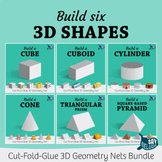Build a 3D Cuboid – Foldable Geometry Solid Shape Net
SayBeluga
500 Followers
Grade Levels
K - 12th, Homeschool
Subjects
Resource Type
Standards
CCSSK.G.A.1
CCSSK.G.A.2
CCSSK.G.A.3
CCSSK.G.B.4
CCSSK.G.B.5
Formats Included
- PDF
Pages
6 pages
SayBeluga
500 Followers
Also included in
- Let students cut, fold and glue solid shapes with these fun printables. Includes both basic outline versions and illustrated real life object versions (color + outline).Original high quality vector artwork.Total of 41 color and blackline pages.Great hands-on activity for geometry to really understanPrice $8.00Original Price $12.50Save $4.50
Description
Let students cut, fold and glue solid shapes with these fun printables.
- Includes both basic outline versions and illustrated real life object versions (color + outline).
- Original high quality vector artwork.
- Total of 6 pages / versions.
Great hands-on activity for geometry to really understand 2D-3D relationships. Let kids draw a real life object on the shapes before assembling to get them to think ahead. Then let them draw an image of the shapes after folding to experience how a 3D shape is represented in 2D.
You can assess the quality of this product by downloading my free version of Build a 3D Cube.
Real life objects included
- Fish tank
- Cereal box
These shapes are part of a series of foldable 3D shapes
Build Six 3D Solid Shapes – Foldable Geometry Net Bundle 1
Build Six More 3D Solid Shapes – Foldable Geometry Net Bundle 2
Build a 3D Triangular-Based Pyramid
Total Pages
6 pages
Answer Key
N/A
Teaching Duration
N/A
Last updated Apr 2nd, 2014
Report this resource to TPT
Reported resources will be reviewed by our team. Report this resource to let us know if this resource violates TPT’s content guidelines.
Standards
to see state-specific standards (only available in the US).
CCSSK.G.A.1
Describe objects in the environment using names of shapes, and describe the relative positions of these objects using terms such as above, below, beside, in front of, behind, and next to.
CCSSK.G.A.2
Correctly name shapes regardless of their orientations or overall size.
CCSSK.G.A.3
Identify shapes as two-dimensional (lying in a plane, “flat”) or three-dimensional (“solid”).
CCSSK.G.B.4
Analyze and compare two- and three-dimensional shapes, in different sizes and orientations, using informal language to describe their similarities, differences, parts (e.g., number of sides and vertices/“corners”) and other attributes (e.g., having sides of equal length).
CCSSK.G.B.5
Model shapes in the world by building shapes from components (e.g., sticks and clay balls) and drawing shapes.






